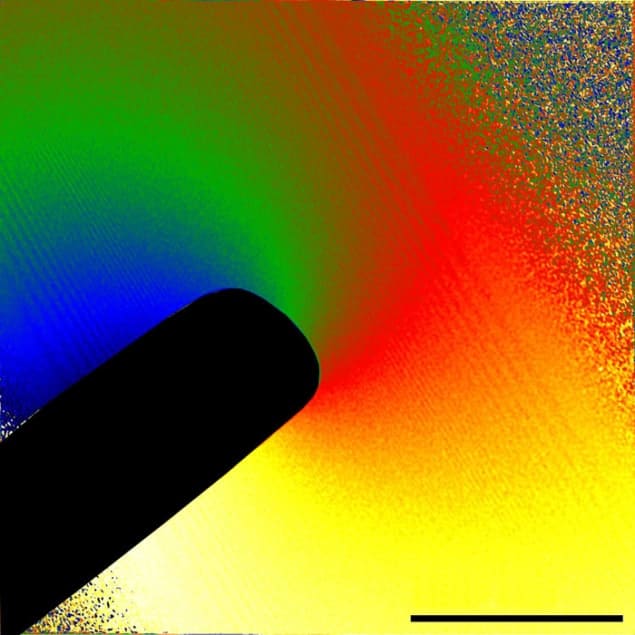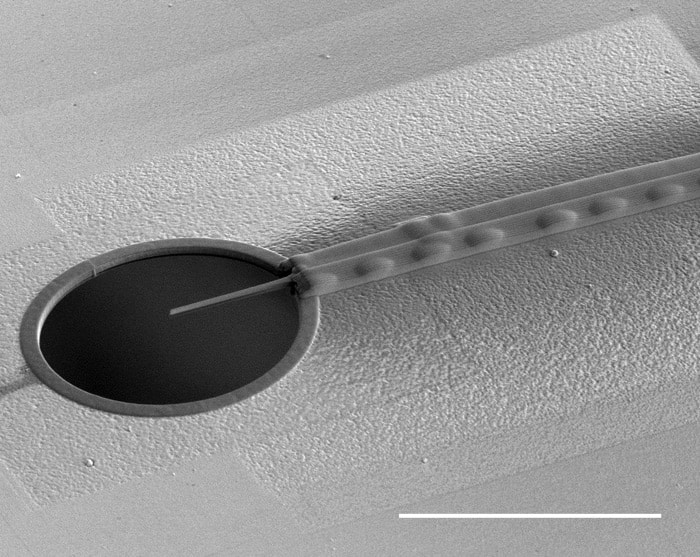
Twisted beams of electrons have been used for the first time to determine the handedness, or “chirality”, of an ultrathin crystal. The new technique, which uses a transmission electron microscope (TEM), has been developed by physicists at the University of Antwerp in Belgium. Their method has been shown to work on samples just 20 nm thick, and the researchers believe that it could be adapted to reveal the chirality of nanoparticles or even single molecules.
Chiral molecules come in two versions called enantiomers, which are mirror images of each other. They have identical atomic compositions but cannot be rotated or otherwise manipulated to have exactly the same structures – in the same way that a person’s right hand can never be the same as their left. Chirality can have a significant effect on the chemical and biological properties of some molecules, making it a measurement of particular interest to those developing new pharmaceutical compounds.
The chirality of molecules in a relatively large sample can be measured by passing polarized light through it. If the sample contains equal numbers of right- and left-handed molecules, the polarization will not change. However, if there is more of one enantiomer than the other, the polarization will be rotated. The problem is that the interaction is inherently weak, and so does not work with very small samples – particularly nanoparticles and single molecules that are much smaller than the wavelength of the light used.
Twisting wavefronts
A beam of electrons, on the other hand, interacts very strongly with tiny samples, and could offer a way forward. In the new work, Jo Verbeeck performed extensive calculations that showed that, in principle, twisted or “vortex” electron beams can be used to measure chirality. Unlike the beam from a conventional TEM, which can be thought of as a simple plane wave, the wavefront of a vortex beam rotates about its axis of propagation and traces out a spiral. A vortex beam can, therefore, twist in a clockwise (left-handed) or anticlockwise direction, and it is this handedness that makes it particularly sensitive to chirality.
To test their predictions, Verbeeck and colleagues modified their TEM by adding a tiny aperture containing the tip of a long and extremely thin magnetized needle. As the electrons interact only with one pole of the magnet, they behave as if they were interacting with a magnetic monopole, which puts the 300 keV electron beam into a vortex state.
The team used its vortex beams to obtain a series of diffraction patterns from a 20 nm-thick sample of manganous antimonate (Mn2Sb2O7), which is a chiral crystal. Five patterns were recorded with a vortex beam rotating in one direction, followed by five patterns using a beam rotating in the opposite sense. Each diffraction pattern was seen to depend on the vorticity of the beam, which allowed the chirality of the sample to be determined by simply comparing the diffraction patterns.
Symmetry breaking
Verbeeck points out that the chirality of a crystal cannot be determined using a conventional beam of electrons because of Friedel’s law, which imposes inversion symmetry on the diffraction pattern. Although chirality does show up in diffraction patterns that are formed when the electrons scatter lots of times in the sample, Verbeeck points out that this kind of multiple scattering rarely occurs in very thin samples, making the vortex-beam method more practical.
However, Verbeeck does admit that several challenges must be overcome before the technique can be used to study single molecules. One is that – unlike the Mn2Sb2O7 crystal – many single molecules would be blown to pieces by the electron beam before the diffraction patterns can be obtained. One way round this, according to Verbeeck, is to make the measurements very quickly.
Another challenge is related to the fact that the technique involves orienting the crystal structure of the sample in a very precise direction with respect to the electron beam. While this is relatively easy to do with a large crystal, it is much harder for nanoparticles and single molecules. To address this issue, Verbeeck and colleagues are now doing calculations and experiments to see if the technique can be used to determine the chirality of randomly oriented crystals.
The technique is described in Physical Review B.




